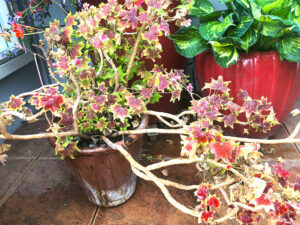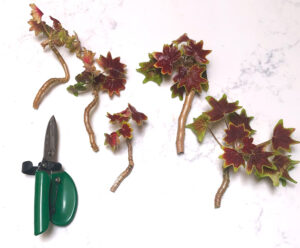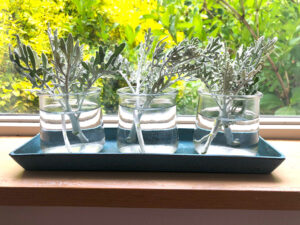
Let’s face it, a real joy of gardening comes from buying plants. However, consider taking cuttings from tried-and-true plants in your own garden or greenhouse. It’s a game of numbers. This replication allows you to design with large drifts of the same plant, or repeat certain plants in various containers in order to visually unite a grouping. These multiple cuttings can be placed on a greenhouse bench, or in a sunny windowsill while they are growing up.
Take Cuttings from Easy-to-root Plants

What’s easy? It’s been my experience that certain houseplants like golden pothos (Epipremnum aurea) are very good at making new roots. In the garden, colorful coleus (Coleus scutellarioides), gray-leafed dusty miller (Senecio cineraria), zonal geraniums such as Pelargonium ‘Vancouver Centennial’, and many hardy sedums will root with alacrity. But the best way to find out what works for you is to experiment. Later in the summer, you can try it with woody plants, but now is the time for plants with soft growth. The bonus? Taking a cutting from the original plant encourages more sturdy growth by stimulating side shoots to come forward. Here are two easy ways to do it.
Plants in a Bag

I fill a plastic gallon bag half way with moistened perlite. I take cuttings with sharp snips, leaving enough stem with several leaf nodes (leaves carefully removed) below the top few leaves. These nodes will convert to making roots. I dip the bottoms in rooting hormone powder and insert in the perlite up to the top rosette of leaves. I fill the bag with the cuttings about an inch apart.
Zip and place on a greenhouse bench or a windowsill with morning light. The upper leaves should remain turgid. If they wilt, well, that wasn’t the right method for those plants. Dump out, wash the perlite, and try again with different plants.
Within a few weeks, check the bag. Add some water if dry—not likely—and pull a cutting to check the roots. If looking moldy, leave the bag open to the air. For sure there are functioning roots when a new leaf appears on top. Then transfer the cuttings into individual four-inch pots to continue to grow. Keep the soil moist but not soaking. As they get bigger, allow them to dry out a bit between waterings. Then you have a collection of plants to add to spring containers or borders and enjoy all summer.
Plants in Water

Pothos, spider plant, and coleus, among many others, root easily in water. Fill some clear glass jars with water, prepare the cuttings with stem leaves removed leaving the top few—no rooting hormone required—and place them in the jars. Change the water as it evaporates or discolors. Shortly, stems will start pushing out white roots. These are fragile water roots. When transferring the rooted cuttings into pots with a light soil mix, keep the moisture level high at first, and then back off, because the cuttings must have time to form tougher and darker roots suitable for life in the soil. That may take a few weeks, but when you see new leaves pushing out, you’ll know they made it. Enjoy.


